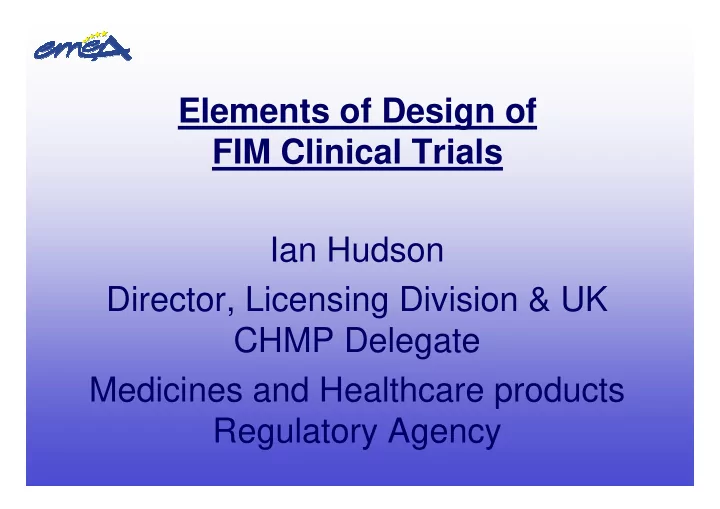

Elements of Design of FIM Clinical Trials Ian Hudson Director, Licensing Division & UK CHMP Delegate Medicines and Healthcare products Regulatory Agency
Points to Consider: � Subject safety is paramount; efficacy is not expected � Choice of subjects � Route and rate of administration � Calculation of dose � Precautions to apply between doses within cohorts
Points to Consider (continued): � Precautions to apply between cohorts � Dose escalation scheme � Stopping rules and decision making � Monitoring for adverse events � Site of clinical trial
General Considerations � Subjects safety rights and well being are paramount � In general, the higher the potential risk associated with the type of medical product and its target, the greater the precautionary measures that should be applied
Choice of Subjects � Healthy subjects or patients - Fully justified by sponsor on a case-by-case basis considering � Risks inherent in type of medicinal product � The target; presence of target in normal vs. disease state � Potential for toxicity; short and long term � Possible higher variability in patients � Relevance of data to intended clinical use � Clear inclusion/exclusion criteria � Subjects should not simultaneously be in another trial
Route and Rate of Administration � Carefully considered and justified � iv administration: slow infusion over several hours, preferable to slow bolus
Precautions to apply between doses within cohort � Sequential design � Adequate period of observation between administration � Justified on a case by case basis taking into account all available information � Number of subjects depends on trial objectives and variability of PK/PD parameters
Precautions to apply between cohorts � Prior to dose escalation, results from prior cohort fully considered (and all subjects dosed) including PK, PD, safety � Assumptions made in designing dose escalation regime should be revisited as new data becomes available � Time interval between cohorts should be guided by existing non- clinical and clinical PK/PD data and, if available, already existing experience with comparable products
Precautions to apply between cohorts (continued) � Dose escalation increments justified on case by case basis taking into account PD aspects including steepness of dose response curve, and other available information, dose/toxicity and dose/effect relationship in non-clinical studies should guide dose increments until clinical data becomes available. � Steeper the increase in dose toxicity or dose effect curves, lower dose increment that should be selected. � Choice of dose level should include some estimate of potential PD/or adverse effects
Stopping Rules � Protocol should define stopping rules � Consider use IDSMB � Define clear procedure for decision making
Monitoring for Adverse Events/Reactions � Provide specific plan for monitoring for AE’s � Consideration of likely AE’s � Training in identification and management of AE’s � Define treatment strategy for predictable adverse reactions � Consider antidotes, supportive treatment, access to treatment allocation codes � Clear procedures for communication of SUSAR’s � Consider potential long term safety issues and therefore duration of monitoring period
Site of Clinical Trial � Appropriate facilities � Appropriate training and expertise � Understanding of IMP, target, mechanism � Immediate access to facilities for treatment of medical emergencies, stabilising individual and readily availability of ICU � Preferably conduct at single site
Comments � Is there too much focus on healthy volunteer trials � Not sufficiently covering issues in patient trials eg oncology � Guidance not acknowledging that toxicity may be endpoint of trial � Site – not overly restrictive � Not restrict to single site if patient trial � More clarity in relation to ICU � IDSMB � Use fairly uncommon � Could IEC role be enhanced � Is it appropriate? � ? Case by case
Comments continued) � Greater definition of what constitutes acceptable level of risk � Section on consent � Basis of R/B analysis � Degree to which factors are unknown � Information � Multiple single doses � Possible benefit � Degree of uncertainty around risk � Long term monitoring/consequences � Little likely to be known at this stage � Some difficulties, lack of clarity � Targeted, case by case
Comments (continued) � More emphasis that same or slower rate administration as used in animal trials � Control of dose � Discussion of duration � Uncertainty in estimated first dose should be quantified and explained � More specific recommendations on drug dosing and number of subjects, recommendation that at least 1 subject be dosed with placebo on same day � All data before dose escalation? � Impractical � Relevant data � Sufficient data � Prespecify what
Recommend
More recommend